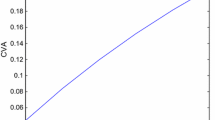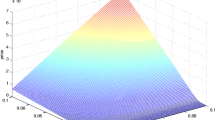Abstract
Equilibrium pricing of credit default swaps (CDS) promotes efficient identification of credit risk in the market, which in turn leads to efficient allocation of resources. However, even when CDS have been priced in equilibrium, i.e., when premiums are equal to anticipated payments, the moral hazard incentives of CDS buyers increase with CDS transactions. Consequentially, it becomes an interesting research direction to study the impact of moral hazard incentives on the trading mechanism or pricing of derivatives (CDS). Most of the existing literature on the impact of moral hazard incentives in CDS pricing on derivatives trading mechanisms takes a macro perspective and focuses on the agreement risk effect. The literature exploring the analysis of the impact of moral hazard on the probability of agreement default from a micro perspective is not yet available. With this in mind, this paper focuses on the mechanisms by which “fraud”, an extreme manifestation of micro-moral hazard incentives, affects the probability of default. This paper introduces for the first time the concept of “claiming fraud” by credit protection buyers, which is different from the macro perspective of moral hazard incentives, and thus defines a specific extreme form of moral hazard incentives. Meanwhile, to address the intrinsic feature of the lack of economic explanatory power of the reduce-form model, this paper introduces a moral hazard incentive factor into the reduce-form model, and proposes a moral hazard state variable as a function of the asset value of the reference entity, which gives the reduce-form model strong economic explanatory power, and the default predictability is reduced by the description of the reduce-form model. In terms of the object of study, this paper considers the issue of moral hazard incentives in the presence of claiming fraud in two reference entities to further explore the impact of moral hazard incentives on default protection at the micro level in terms of cyclic default. Finally, based on the analysis of the results of the numerical simulation experiments, it is proposed that increasing the number of reference assets for CDS buyers will help to reduce the moral hazard incentives of the buyer, and thus the anticipated payments to the buyer, i.e., we attempt to endogenize the credit risk of an asset by allowing the asset holder to choose the probability of the asset going up or down, which helps to understand the phenomenon of moral hazard incentives in CDS trading.
Similar content being viewed by others
Data Availability
The datasets generated during and/or analysed during the current study are available from the corresponding author on reasonable request.
References
Acharya V, Bisin A (2014). Counterparty risk externality: Centralized versus over-the-counter markets. Journal of Economic Theory 149: 153–182.
Ai J, Brockett P L, Golden L L (2009). Assessing consumer fraud risk in insurance claims: An unsupervised learning technique using discrete and continuous predictor variables. North American Actuarial Journal 13(4): 438–458.
Amiram D, Beaver W H, Landsman W R, Zhao J X (2017). The effects of credit default swap trading on information asymmetry in syndicated loans. Journal of Financial Economics 126(2): 364–382.
Arrow K J (1968). The economics of moral hazard: Further comment. The American Economic Review 58(3): 537–539.
Ballestra L V, Pacelli G, Radi D (2020). Modeling CDS spreads: A comparison of some hybrid approaches. Journal of Empirical Finance 57: 107–124.
Biagini F, Mazzon A, Oberpriller K (2023). Reduced-form framework for multiple default times under model uncertainty. Stochastic Processes and Their Applications 156: 1–43.
Biais B, Heider F, Hoerova M (2016). Risk-sharing or risk-taking? Counterparty risk, incentives, and margins. The Journal of Finance 71(4): 1669–1698.
Black F, Cox J C (1976). Valuing corporate securities: Some effects of bond indenture provisions. The Journal of Finance 31(2): 351–367.
Bolton P, Oehmke M (2011). Credit default swaps and the empty creditor problem. The Review of Financial Studies 24(8): 2617–2655.
Carverhill A, Luo D (2020). Pricing and integration of credit default swap index tranches. Journal of Futures Markets 40(4): 503–526.
Chakraborty I, Chava S, Ganduri R (2015). Credit default swaps and moral hazard in bank lending. Unpublished working paper, University of Miami and Georgia Institute of Technology.
Chakraborty I, Chava S, Ganduri R (2020). Credit default swaps and lender incentives in renegotiations of bank debt. SSRN Electronic Journal. DOI: https://doi.org/10.2139/ssrn.2541102.
Chakraborty I, Chava S, Ganduri R (2023). Credit default swaps and lender incentives in bank debt renegotiations. Journal of Financial and Quantitative Analysis 58(5): 1911–1942.
Collin-Dufresne P, Goldstein R, Hugonnier J (2004). A general formula for valuing default-able securities. Econometrica 72(5):1377–1407.
DeMarzo P, Duffie D (1999). A liquidity-based model of security design. Econometrica 67(1): 65–99.
Díaz A, Jareño F, Navarro E (2022). Yield curve data choice and potential moral hazard: An empirical exercise on pricing callable bonds. International Journal of Finance & Economics 27(2): 2124–2145.
Diamond D W (1984). Financial intermediation and delegated monitoring. Review of Economic Studies 51(3): 393–414.
Du L, Huang J, Jain B A (2019). Tournament incentives and firm credit risk: Evidence from credit default swap referenced firms. Journal of Business Finance & Accounting 46(7–8): 913–943.
Fons J S (1994). Using default rates to model the term structure of credit risk. Financial Analysts Journal 50(5): 25–32.
Giesecke K (2006). Default and information. Journal of Economic Dynamics & Control 30(11): 2281–2303.
Gong Y (2020). Credit default swap and two-sided moral hazard. Finance Research Letters 34: 101254.
Guo J, Qian X, Wang G (2021). Pricing default risk in mortgage-backed securities under a regime-switching reduced-form model. Communications in Statistics - Theory and Methods 50(9): 2117–2135.
Hao R L (2011). Pricing credit securities in the contagious model. Ph.D Dissertation, Shanghai Jiao Tong University.
Hong H A, Lobo G J, Ryou J W (2019). Financial market development and firm investment in tax avoidance: Evidence from credit default swap market. Journal of Banking & Finance 107: 105608.
Hu HTC, Black B (2007). Equity and debt decoupling and empty voting II: Importance and extensions. University of Pennsylvania Law Review 156: 625.
Jeon J, Kim G (2019). Pricing of vulnerable options with early counterparty credit risk. The North American Journal of Economics and Finance 47: 645–656.
Lando D (1998). On Cox processes and credit risky securities. Review of Derivatives Research 2(2–3): 99–120.
Leung K S (2016). Essays on exotic option pricing and credit risk modeling. Ph.D Dissertation, Hong Kong University.
Liang, G C, Wang X C (2021). Pricing vulnerable options in a hybrid credit risk model driven by Heston-CNandi GARCH processes. Review of Derivatives Research 24(1): 1–30.
Merton R C (1974). On the pricing of corporate debt: The risk structure of interest rates. The Journal of Finance 29(2): 449–470.
Parlour C A, Plantin G (2008). Loan sales and relationship banking. The Journal of Finance 63(3): 1291–1314.
Parlour C A, Winton A (2013). Laying off credit risk: Loan sales versus credit default swaps. Journal of Financial Economics 107(1): 25–45.
Sambalaibat, B (2012). Credit default swaps and sovereign debt with moral hazard and debt renegotiation. In 2012 Meeting Papers (No. 1093): Society for Economic Dynamics.
Streitz D (2016). The impact of credit default swap trading on loan syndication. Review of Finance 20(1): 265–286.
Subrahmanyam M G, Tang D Y, Wang S Q (2014). Does the tail wag the dog? The effect of credit default swaps on credit risk. The Review of Financial Studies 27(10): 2927–2960.
Thompson J R (2010). Counterparty risk in financial contracts: Should the insured worry about the insurer. The Quarterly Journal of Economics 125(3): 1195–1252.
Wu L, Zhuang Y M (2015). A reduced-form intensity-based model under fuzzy environments. Communications in Nonlinear Science and Numerical Simulation 22(1):1169–1177.
Bai Y F (2008). Modelling contagion effect of credit risk and pricing of credit derivatives. Ph.D Dissertation, Shanghai Jiao Tong University.
Yu F (2003). Correlated defaults in reduced-form models, Workingpaper. University of California, Irvine.
Zhu L, You J (2011). Moral hazard strategy and quality contract design in a two-echelon supply chain. Journal of Systems Science and Systems Engineering 20(1): 70–86.
Acknowledgements
The authors would like to extend their sincere gratitude to the referees for their valuable feedback and suggestions, which significantly contributed to the improvement of the quality of this paper.
Author information
Authors and Affiliations
Corresponding author
Ethics declarations
The authors declare that they have no known competing financial interests or personal relationships that could have appeared to influence the work reported in this paper.
Additional information
Liang Wu received his B.Sc. degree from China University of Geosciences(Wuhan, Hubei) in 2005, the M.S. degree from Henan Normal University(Xinxiang, Henan) in 2011, and the Ph.D. degree from Southeast University (Nanjing, Jiangsu) in 2016, all in mathematics. From 2018 to so far, he worked as an associate professor at Henan Institute of Science and Technology(Xinxiang, Henan). From 2016 to 2020, he conducted Postdoctoral research at Henan University(Kaifeng, Henan). His research interests include application of risk management system, mathematical finance, fintech, fuzzy set applications. Dr. Wu is a member of the Financial Engineering Society of Henan Province, He is the author or co-author of more than 10 papers published in scientific journals.
Kangjie He received her B.Sc. degree from Henan Institute of Science and Technology(Xinxiang, Henan) in 2018, the M.S. degree from Henan Institute of Science and Technology (Xinxiang, Henan) in 2023, all in mathematics. Her research interests include risk analysis, mathematical finance.
Zhe Guo received his B.Sc. degree from Shenyang Agricultural University(Shenyang, Liaoning) in 2018, the M.S. degree from Henan University(Kaifeng, Henan) in 2020, all in financial economics. His research interests include financial economics, mathematical finance.
Rights and permissions
About this article
Cite this article
Wu, L., He, K. & Guo, Z. Research on Credit Default Swaps Pricing Considering Moral Hazard Incentive under Reduce-Form Model. J. Syst. Sci. Syst. Eng. (2024). https://doi.org/10.1007/s11518-024-5592-1
Published:
DOI: https://doi.org/10.1007/s11518-024-5592-1




